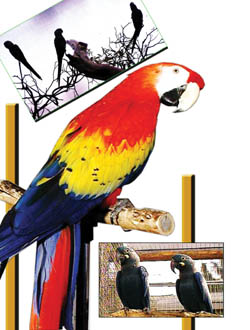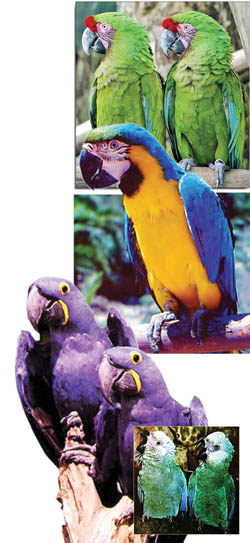|
observer |
|
|
|
|
|
OTHER LINKS |

|

|

|
|
|
|
|
Found mostly in Central and South America, in a wide variety of habitats such as tropical rainforests to arid regions, these birds are not only large with long tails, but also have more brightly coloured feathers than other species of parrots. They also have strong, hooked beaks, harsh voices and bear patches around the eyes.
Around 18 species of macaws have been recognised, but as the majority of them are highly endangered, two species are already believed to have become extinct. The major reason the birds are threatened is due to rapid deforestation of habitats and illegal trapping for the bird trade.
The two species that became extinct in modern times are the Glaucus and Cuban macaws. There are no records of Glaucus macaws beyond 1860 and the Cuban macaw too was last recorded in 1864.
This leaves 16 species of macaws which include the Hyacinth macaw, Lear's (Indigo) macaw, Spix's macaw (which may be even extinct by now as only one species exists in this genus), Blue and Yellow (Blue and Gold) macaw (very common and not endangered), Genus Ara, Blue-throated macaw Great Green (Buffon's), Scarlet macaw, Military macaws, Severe macaws and Hahu's macaw.
In general, these macaws are known as guacamayas in Spanish while the Brazilian name for them is ara and arara.
Both these Brazilian names are descriptive of their vocalizations.
Most species of macaws have brilliant, contrasting coloured plumages, but some have one or two tones such as blue and yellow, like the anodorhynchus. Not only their colours, even their bill or beak structure is different to that of typical macaws.
|
|
Unlike the other macaws, the Hyacinth, Glaucus, Lear's and the recently placed Indigo macaws which belong to this group do not have beaks with tooth-like ridges to aid in food consumption.
This group of macaws are all large, have blue coloured feathers, yellow rings round the eyes and yellow cheeks.
The pet macaws, and even those in the wilds need plenty of chewing material to keep their constantly growing beaks worn down. All macaws eat fruits, seeds, nectar, and nuts. They open the seeds with their strong beaks. Macaws are also known to destroy trees.
Though they are mostly found near rivers and streams, they fly long distances in search of food.Their favourite nest sites are holes in trees, particularly ones in dead trees or cavities in cliff faces. They have one or two young each year.
The young, who are slow to develop remain in the nest for up to four months and even after leaving the nest, they continue to stay with their parents till the next breeding season. Macaws display a great amount of intelligence and need intellectual stimulation to satisfy their innate curiosity. Many are kept as pets.
As their average lifespan is a minimum of 50 years with the larger species exceeding even 65 years, they could be lifelong pets. In fact, having a macaw as a pet is a lifetime commitment because some may even outlive their owners.
Macaws generally mate for life, so, if they don't have a mate, they bond with their owners in captivity. They thrive on physical contact, handling interaction and love. If they lack any of these, the pet macaws could suffer from mental and physical problems.
Let's check out facts about some of these species of macaws
Hyacinth Macaw
It is believed that there are only around 3,000 or less Hyacinth macaws in the wild. It is the largest among the macaws and is capable of flight. It's around 90-100 cm in length and 1,250 grams in weight.
The Kakapo of New Zealand is considered to be the heaviest, but this bird is flightless. There are also some Great Greens and Green macaws that either equal or exceed the hyacinth in size, but in general it is the hyacinth that is considered the largest of the parrot family.
The Hyacinth macaw eats fruits, seeds and nuts like all others in the parrot family and nests in burrows hollowed out with their beaks. Their powerful beaks can crack even coconuts. One of the common misconceptions is that the hyacinth macaw is primarily a rainforest bird. But it avoids heavily forested areas throughout its range. It prefers lightly forested areas.
Their popularity as pets has taken a heavy toll on their population in the wild.
Hahn's Macaw
This bird is considered to be the finest in the family with a plumage of generally green with a bluish green forehead. It is the smallest of all macaws and easy to care for as a pet. This bird is also known as Red Shouldered Macaw, Hahn's Miniature Macaw and Hahn's Mini Macaw. It grows to about 13 inches in length.
Glaucus Macaw
Even though this bird is now extinct, a specimen of this bird has revealed that it had a pale turquoise blue plumage and a greyish blue head. Its size had been around 28 inches in length.
Lear's (Indigo) Macaw
The common and scientific name of this bird is in honour of Edward A. Lear, popular British artist and writer of nonsense books and stories which include the famous poem many students learn - 'The Owl and the Pussycat'.
Smaller than the other macaws, this species is more threatened than the hyacinth. Its plumage is a lighter and duller shade of blue. In fact, it is a more greenish blue in colour. It has a large, half moon shaped and less deeply coloured cheek patch. The size is around 70-75 centimetres in length.
The bird is known as a palm nut specialist because it is believed to consume around 70-100 licuri palm nuts per day.
Spix's (little blue) Macaw
Greyish blue in colour with striking triangular facial patches, the Spix's Macaws have a distinctive and bizarre appearance. They are around 550 centimetres in length and around 350 grams in weight on an average. By the turn of the millennium, only one bird existed in the wild.
Blue and Yellow Macaw
Also known as the Blue and gold macaw, they are one of the most commonly seen birds in captivity. These birds have ultramarine blue upper surfaces (tail and flight feathers are blue above, golden yellow below), green foreheads, black throats and large white facial patches. Black feathers make distinctive narrow lines on the otherwise bare face. The black bill adds to the striking appearance.
Military Macaws
They belong to the larger group of macaws. Their body feathers are mostly green with a red forehead and pale blue rump. They have large bare facial patches which are lined with black feathers and sometimes red feathers. The white faces seem pink in colour due to the blush effect.
Scarlet Macaw
One of the most beautiful macaws with a plumage of scarlet red, orange, golden yellow, deep green and powder blue. They have large bare facial patches and lack noticeable feather lines. These birds which are around 80-96 cm in length, and about a kilogram in weight, prefer dry forests in Mexico. It has a varied diet. They make loud, - low-pitched throaty squawks and screams.
While only eight species are said to exist in Genus Ara, even the Blue-throated macaw is considered highly endangered with only 50-1000 birds in existence.
Over the past 100 years, over half the world's macaws have disappeared with some ending up in captivity as pets.
Look out for some interesting facts about yet another bird in the parrot family next week.











